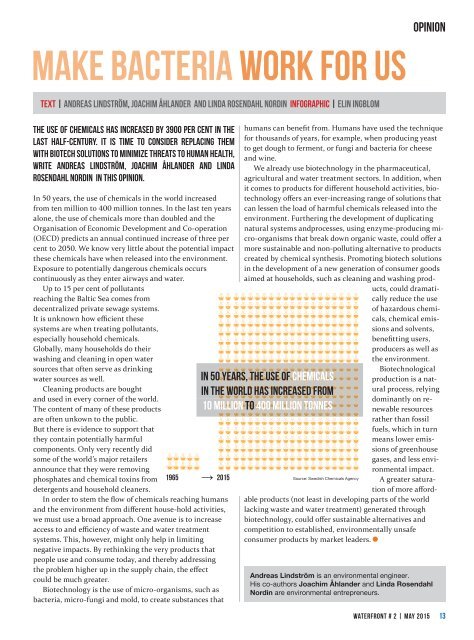Waterfront #2 2015: Always something new out of Africa
Create successful ePaper yourself
Turn your PDF publications into a flip-book with our unique Google optimized e-Paper software.
OPINION<br />
MAKE BACTERIA WORK FOR US<br />
TEXT | andreas lindström, Joachim Åhlander and Linda Rosendahl Nordin INFOGRAPHIC | elin ingblom<br />
The use <strong>of</strong> chemicals has increased by 3900 per cent in the<br />
last half-century. It is time to consider replacing them<br />
with biotech solutions to minimize threats to human health,<br />
write andreas lindström, Joachim Åhlander and Linda<br />
Rosendahl Nordin in this opinion.<br />
In 50 years, the use <strong>of</strong> chemicals in the world increased<br />
from ten million to 400 million tonnes. In the last ten years<br />
alone, the use <strong>of</strong> chemicals more than doubled and the<br />
Organisation <strong>of</strong> Economic Development and Co-operation<br />
(OECD) predicts an annual continued increase <strong>of</strong> three per<br />
cent to 2050. We know very little ab<strong>out</strong> the potential impact<br />
these chemicals have when released into the environment.<br />
Exposure to potentially dangerous chemicals occurs<br />
continuously as they enter airways and water.<br />
Up to 15 per cent <strong>of</strong> pollutants<br />
reaching the Baltic Sea comes from<br />
decentralized private sewage systems.<br />
It is unknown how efficient these<br />
systems are when treating pollutants,<br />
especially household chemicals.<br />
Globally, many households do their<br />
washing and cleaning in open water<br />
sources that <strong>of</strong>ten serve as drinking<br />
water sources as well.<br />
Cleaning products are bought<br />
and used in every corner <strong>of</strong> the world.<br />
The content <strong>of</strong> many <strong>of</strong> these products<br />
are <strong>of</strong>ten unkown to the public.<br />
But there is evidence to support that<br />
they contain potentially harmful<br />
components. Only very recently did<br />
some <strong>of</strong> the world’s major retailers<br />
announce that they were removing<br />
phosphates and chemical toxins from<br />
detergents and household cleaners.<br />
1965<br />
<strong>2015</strong><br />
In order to stem the flow <strong>of</strong> chemicals reaching humans<br />
and the environment from different house-hold activities,<br />
we must use a broad approach. One avenue is to increase<br />
access to and efficiency <strong>of</strong> waste and water treatment<br />
systems. This, however, might only help in limiting<br />
negative impacts. By rethinking the very products that<br />
people use and consume today, and thereby addressing<br />
the problem higher up in the supply chain, the effect<br />
could be much greater.<br />
Biotechnology is the use <strong>of</strong> micro-organisms, such as<br />
bacteria, micro-fungi and mold, to create substances that<br />
humans can benefit from. Humans have used the technique<br />
for thousands <strong>of</strong> years, for example, when producing yeast<br />
to get dough to ferment, or fungi and bacteria for cheese<br />
and wine.<br />
We already use biotechnology in the pharmaceutical,<br />
agricultural and water treatment sectors. In addition, when<br />
it comes to products for different household activities, biotechnology<br />
<strong>of</strong>fers an ever-increasing range <strong>of</strong> solutions that<br />
can lessen the load <strong>of</strong> harmful chemicals released into the<br />
environment. Furthering the development <strong>of</strong> duplicating<br />
natural systems andprocesses, using enzyme-producing micro-organisms<br />
that break down organic waste, could <strong>of</strong>fer a<br />
more sustainable and non-polluting alternative to products<br />
created by chemical synthesis. Promoting biotech solutions<br />
in the development <strong>of</strong> a <strong>new</strong> generation <strong>of</strong> consumer goods<br />
aimed at households, such as cleaning and washing products,<br />
could dramatically<br />
reduce the use<br />
<strong>of</strong> hazardous chemicals,<br />
chemical emissions<br />
and solvents,<br />
benefitting users,<br />
producers as well as<br />
the environment.<br />
Biotechnological<br />
production is a natural<br />
process, relying<br />
dominantly on re<strong>new</strong>able<br />
resources<br />
rather than fossil<br />
fuels, which in turn<br />
means lower emissions<br />
<strong>of</strong> greenhouse<br />
gases, and less environmental<br />
impact.<br />
A greater saturation<br />
<strong>of</strong> more afford-<br />
1965<br />
able products (not least in developing parts <strong>of</strong> the world<br />
lacking waste and water treatment) generated through<br />
biotechnology, could <strong>of</strong>fer sustainable alternatives and<br />
competition to established, environmentally unsafe<br />
consumer products by market leaders.<br />
in 50 years, the use <strong>of</strong> chemicals<br />
in the world has increased from<br />
10 million to 400 million tonnes<br />
In 50 years,<br />
the use <strong>of</strong><br />
chemicals<br />
in the world<br />
has increase<br />
from 10 milli<br />
to 400 millio<br />
tonnes<br />
Source: Swedish Chemicals Agency 20<br />
Andreas Lindström is an environmental engineer.<br />
His co-authors Joachim Åhlander and Linda Rosendahl<br />
Nordin are environmental entrepreneurs.<br />
WATERFRONT # 2 | may <strong>2015</strong><br />
13


















